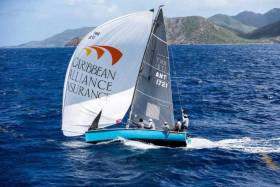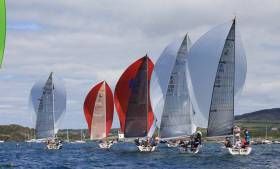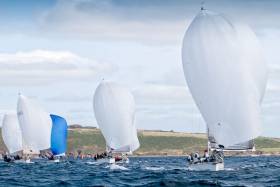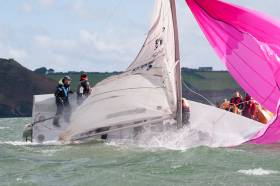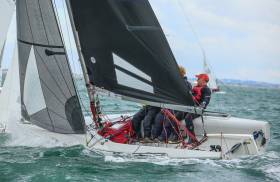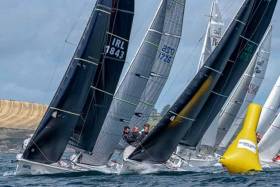Displaying items by tag: 1720
1720 Collision Leaves Plank in Sportsboat Hull at Dun Laoghaire
We're not entirely sure how this plank ended up in the hull of a club 1720 after last Thursday's DBSC race on Dublin Bay but Afloat is reliably informed it is not an experimental foil and much more likely the end result of a 'port and starboard' with the marina. Ouch!
A strong 17-boat 1720 sportsboat fleet bore witness to Anthony O'Leary's dominance of the Royal Irish Yacht Club hosted East Coast Championships on Dublin Bay today.
In strong and gusty north-westerlies averaging 18 to 20 knots that gusted to over 35, Royal Cork's O'Leary won the final two races of the six-race series to pull clear ahead of Howth Yacht Club's Dan O'Grady and wrap up the title in a much-reduced fleet of nine boats.
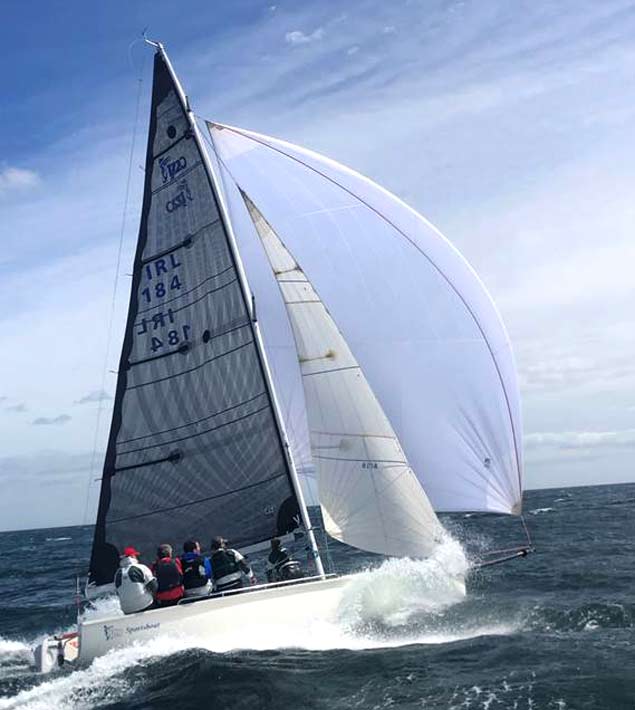 In winning form – Anthony O'Leary on one of the high speed reaches at the 1720 East Coasts. O'Leary's championship-winning Antix was clocked at 16-knots on one of the downwind legs Photo: Mark McGibney/RIYC
In winning form – Anthony O'Leary on one of the high speed reaches at the 1720 East Coasts. O'Leary's championship-winning Antix was clocked at 16-knots on one of the downwind legs Photo: Mark McGibney/RIYC
O'Leary head up a strong travelling Cork contingent that included third-placed Ben Cooke sailing under both the Baltimore Sailing Club and Royal St. George YC burgees.
 Pat Shannon Rear Commodore Sailing of the Royal Irish Yacht Club (left) with 1720 East Coast winner Anthony O'Leary (centre) and UK Sailmakers Ireland's Graham Curran Photo: Mark McGibney/RIYC
Pat Shannon Rear Commodore Sailing of the Royal Irish Yacht Club (left) with 1720 East Coast winner Anthony O'Leary (centre) and UK Sailmakers Ireland's Graham Curran Photo: Mark McGibney/RIYC
Johnny Durcan sailing T-Bone from RCYC was fourth with the Irish National Sailing Club's Alexander Rumball fifth.
In a further boost for 1720 sailing, three under 25 teams competed.
1720 East Coast Championships Results
| Series Place | Sail No | Boat | Helm | Club | Series Points | Race 1 | Race 2 | Race 3 | Race 4 | Race 5 | Race 6 |
|---|---|---|---|---|---|---|---|---|---|---|---|
| 1 | 184 | Antix | Antony O'Leary | RCYC | 8 | 14 | 1 | 3 | 2 | 1 | 1 |
| 2 | 1443 | Wet N Black | Dan O'Grady | Howth YC | 11 | 10 | 3 | 1 | 3 | 2 | 2 |
| 3 | 1722 | Smile n Wave | Ben Cooke | BSC / RSGYC | 17 | 2 | 5 | 18 | 1 | 4 | 5 |
| 4 | 1790 | T-Bone | Johnny Durcan | RCYC | 26 | 11 | 9 | 7 | 4 | 3 | 3 |
| 5 | 1775 | INSC | Alexander Rumball | Irish National Sailing Club | 30 | 7 | 7 | 5 | 5 | 8 | 6 |
| 6 | GBR1791 | Full Bernard | Mark O'Reilly | Baltimore Sailing Club | 34 | 9 | 15 | 8 | 8 | 5 | 4 |
| 7 | GBR1770 | Luvly Jubbly | James Peters | PSC/SCYC | 39 | 5 | 8 | 11 | 9 | 9 | 8 |
| 8 | 1793 | Big Bad Wolf | Andrew Creighton | RIYC | 43 | 1 | 2 | 4 | 18 | 18 | 18 |
| 9 | 17221 | Wolfe | Elizabeth Conway | RSGYC | 44 | 8 | 11 | 10 | 10 | 7 | 9 |
| 10 | 1780 | Mini Apple | David Love | RCYC | 45 | 12 | 14 | 18 | 6 | 6 | 7 |
| 11 | 2800 | Elder Lemon | Robert Dix | Baltimore SC | 48 | 6 | 4 | 2 | 18 | 18 | 18 |
| 12 | 1818 | Merlin | Conor Clancy | RIYC | 48 | 4 | 10 | 9 | 7 | 18 | 18 |
| 13 | 1595 | What did he break | Adam Hyland | RSGYC | 51 | 3 | 6 | 6 | 18 | 18 | 18 |
| 14 | RIYC2 | Toute Si | Delaney McCourt | RIYC | 65 | 17 | 17 | 18 | 11 | 10 | 10 |
| 15 | 1540 | Zelus | Conor Maguire | RIYC | 74 | 15 | 16 | 13 | 12 | 18 | 18 |
| 16 | 11793 | Wow | Tim Kane | RIYC | 76 | 16 | 12 | 12 | 18 | 18 | 18 |
| 17 | RIYC3 | RIYC U25's | Alex Conway | RIYC | 76 | 13 | 13 | 14 | 18 | 18 | 18 |
Royal Cork 1720 Design to Defend Antigua Title
Who would have dreamed it that the Royal Cork Yacht Club 1720 sportsboat design would have crossed the Atlantic and be winning in the Caribbean some 26 years later?
Since first launching in Cork Harbour 1993, the enduring demand for Tony Castro's versatile sportsboat is such that a quarter of a century later it is robustly used throughout the UK and Ireland as a sail trainer, a strict one design, an IRC cruiser and a youth academy boat but who knew of the design's Antiguan success too?
For the 52nd edition of this month's Antigua sailing week, 12 teams racing under the flag of Antigua & Barbuda will be racing, including Jules Mitchell's young 1720 crew, all products of Antigua's National Sailing Academy. Last year the team on NSA Spirit won class and are back, hungry to win in 2019! Over 40 young Antiguans in total will be racing this year on a variety of boats as part of the Youth to Keel Boat (Y2K) Programme but it is Cork's own 1720 that is the defending champion.
More on the week here.
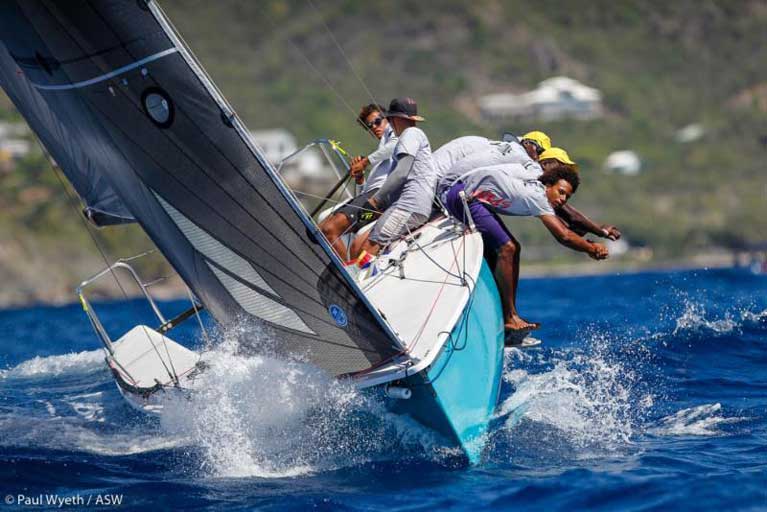 The Antiguan 1720 crew is a youthful affair Photo: Paul Wyeth
The Antiguan 1720 crew is a youthful affair Photo: Paul Wyeth
Royal Cork Yacht Club 1720 Under 25 Sailing Academy in Winter Training Mode
Winter sail training for the Royal Cork Yacht Club Under 25 Keelboat Academy sponsored by EY is continuing in Cork Harbour this February writes Bob Bateman
Primarily using the club's 1720 sportsboats, the Academy is made up of 16 and 25 year-olds who get the chance to experience local sailing in the harbour plus a chance to compete nationwide at Summer events.
As Afloat.ie reported recently here, EY has sponsored the U-25 squad and as part of that North Sails Ireland provided a new spinnaker.
Last season Royal Cork put teams in for match racing events as well as Wave regatta in Howth YC, Volvo Cork Week, the 1720 Nationals and Europeans.
 Winter sail training for the Royal Cork Yacht Club Under 25 Keelboat Academy is continuing in Cork Harbour, Photo Bob Bateman
Winter sail training for the Royal Cork Yacht Club Under 25 Keelboat Academy is continuing in Cork Harbour, Photo Bob Bateman
Atara Wins 12–boat 1720 Baltimore Cup in West Cork
Twelve 1720s sportsboats were afloat for racing on Saturday afternoon at Baltimore Regatta in West Cork. PRO Colette O'Flynn and her team got three races away in light, shifty breezes with the Hegarty's on efolioaccounts.com taking two wins and Atara raced by Ross McDonald and Aoife English taking the final race of the day.
Download overall results below
Sunday morning saw the breeze build to 12 knots with Atara showing her winning ways in Race 4, Elder Lemon won the fifth and Full Bernard the sixth.
"Current National Champions Atara were overall winners with Davy Ryan of Big Bad Wolf second"
With a full series completed the fleet came ashore to enjoy the festive atmosphere of Baltimore Regatta Weekend.
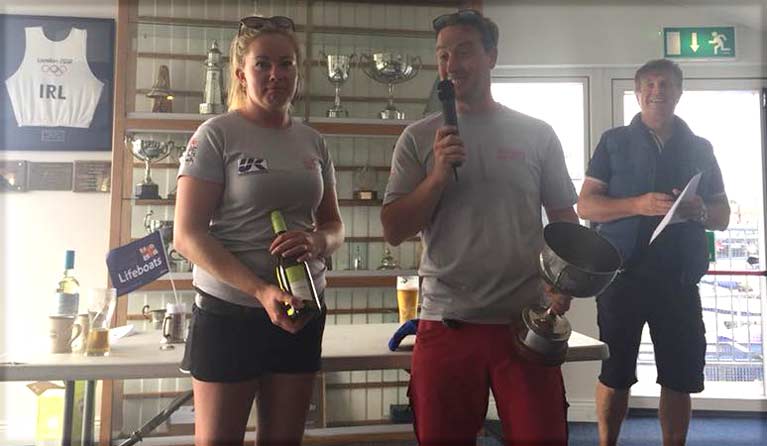 Aoife English and Ross McDonald were winners on Atara Photo: Deirdre Horgan
Aoife English and Ross McDonald were winners on Atara Photo: Deirdre Horgan
Current National Champions Atara were overall winners with Davy Ryan of Big Bad Wolf second, and Peter O'Flynn's Two to Tango in third.
The bulk of the fleet are now staying in Baltimore and will be joined by others for the 1720 Nationals at Baltimore Sailing Club on 30 August - 1 September.
Royal Cork Yacht Club Sets Up Keelboat Academy
The loss of young sailors to the sport is an issue that has been identified by many clubs around the country and at national level.
Other sports can be more attractive to younger age groups, particularly it seems as teenagers enter the early 20s and there are increasingly more all-year-round possibilities for young people, male and female - and without the rigours of an uneven playing field, as the water is described, compared to land-based sports.
This was discussed at a ‘think-in’ at the Royal Cork in Crosshaven late last year when the cruiser racing section reviewed the past season.
Now the club has announced the setting-up of an Under 25s Keelboat Academy.
The intention is to try to get more young people interested in cruiser racing from the age of 16 years onwards and it’s an attractive alternative to losing them from the sport altogether
An invitation has been sent out through the club’s system to those between the ages of 16 and 25 to join the Keelboat Academy….. the age limits are 16 by the age of May 1 this year and not over 25 by the same date.
The club's 1720s boats will be used for training, learning boat maintenance and tuning keelboats and there will also be opportunities to go to events around the country representing the Club on other boats such as J24s and J80s.
The RCYC is entering a team for the Irish Cruiser Racing Association Nationals in Galway from August 15 to 18 to race against six other U25 teams from clubs around the country and the Crosshaven establishment says it will also be looking at putting teams in for some match racing events at the Wave Regatta in Howth Yacht Club in Dublin, at Volvo Cork Week, in the Youth Regatta and the 1720 National and European Championships.
Within a short time of announcing the Academy, fourteen younger sailors had signed up. It’s a good initiative. RCYC Keelboats Rear Admiral, Kieran O’Connell, who is also Commodore of the South Coast Offshore Racing Association, says the plan is to get the Academy “up and running as soon as possible.”
• Podcast here
Big 1720 Fleet Prepare for CH Marine Autumn Series at Royal Cork Yacht Club
The CH Marine Autumn Series at Royal Cork Yacht Club is rapidly approaching, one of the premier highlights of the sailing season on the south coast, that always attracts large numbers of sailors from a wide variety of clubs from around Ireland.
CH Marine have sponsored this event for a number of years and have enabled the club to stage the popular event which is continuing to grow year after year and comes straight after the end of RCYC's September series, report here.
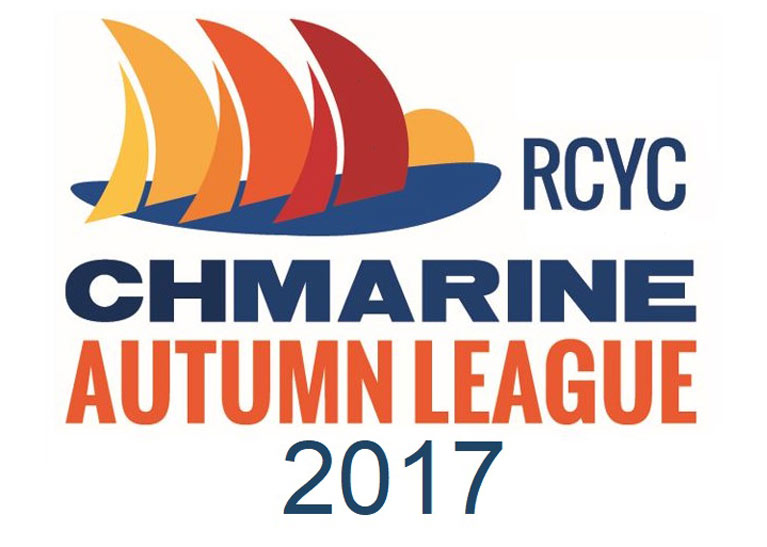
This year the CH Marine Autumn Series will commence on Sunday, October 1st with the first two races and will follow with two races each Sunday in October finishing on Sunday October 29th. Racing will commence each day at 1055hrs, and will be followed each day by food, music and daily prize giving.
Notice of Race and Entry forms are downloadable for the CH Marine Autumn Series below.
Over the last few years there has been a great 1720 fleet building for the CH Marine Autumn Series, with 13 boats competing last year.
This year is looking like the 1720 class will not disappoint with a large number of early entries.
On the final day of racing the CH Marine Autumn Series dinner and overall prize giving will be held at the club commencing at 19.30hrs.
Subject to availability, complimentary berthing on swinging moorings or marina berths will be provided to yachts visiting.
For marina berthing arrangements contact Mark Ring at Royal Cork office +353(0)214831023.
Aoife English & Ross McDonald Win 1720 Irish Title at Baltimore Sailing Club
Aoife English and Ross McDonald were winners of the 2017 Irish 1720 National Championship at Baltimore Sailing Club yesterday by a single point.
The Howth Yacht Club helmsman beat a 17–boat fleet including past champions second placed Robert and Peter O'Leary and third placed Anthony O'Leary in the two day event.
English and McDonald were the only crew to count all top five placings in a very consistent showing across the eight race series. Results are below:

The 2017 Spring Warmer series sponsored by Key Capital Private came to a conclusion at Howth Yacht Club on Saturday. The final day of the season opener provided the sailors with some champagne sailing conditions with 15–knots of breeze and glorious sunshine.
In the Cruiser Class Paddy Kyne’s Maximus with two race wins took the honours by one point from the very consistent Flashback (Patterson/Paddy Gregory /Don Breen). In third place was Stephen Quinn’s Lambay Rules.
The J24 racing was dominated by Steve Atkinson’s Bad with three first places and a fourth. Second was Jumpin Jive (M. Usher). The new K25 team completed the podium. It was great to see three K25 youth teams out competing.
Howth Yacht Club’s “Taste of Sailing” initiative goes from strength to strength. The programme sees experienced sailors racing with those new to the sport or new to HYC. Five teams took to the club J80s for the Spring Warmer this year.
The SB20 fleet was the largest fleet with 10 boats. Locals Shane Murphy, Daragh Sheridan and John Phelan on Two Men & Their Monkey won the event with a race to spare from Colin Galavan’s Sacrebleu who scored a race win in the final race with a fantastic first run setting them up for a big lead which they never relinquished. Third place was Dave Barry on Lia.
The SB20s are staying in the same venue for their Eastern Championships to be held in two weeks’ time on 21 & 22 April.
The prizegiving took place with Vice Commodore Emmet Dalton on hand to present the prizes.
Sailing with Dutch sail numbers Anthony O'Leary has won all six races of the Sportsboats April League at Royal Cork Yacht Club writes Bob Bateman.
Sailing a 1720, the former Afloat Sailor of the Year leads Cork Harbour club–mates Clive O' Shea and Tom Durcan in another of the Royal Cork's own 1720 designs.
Third in the seven–boat fleet is a J80, Rioja, sailed by Ernie Dillon and Dominic Baxter. Full results downloadable below.




























